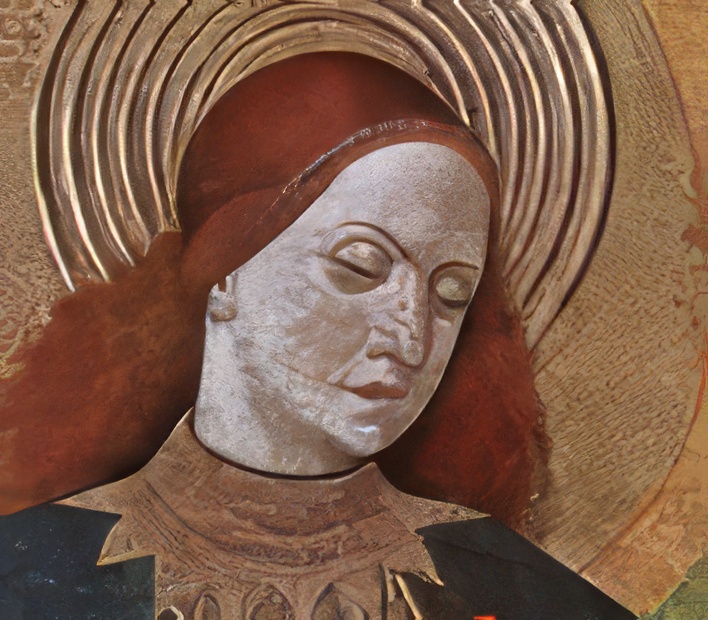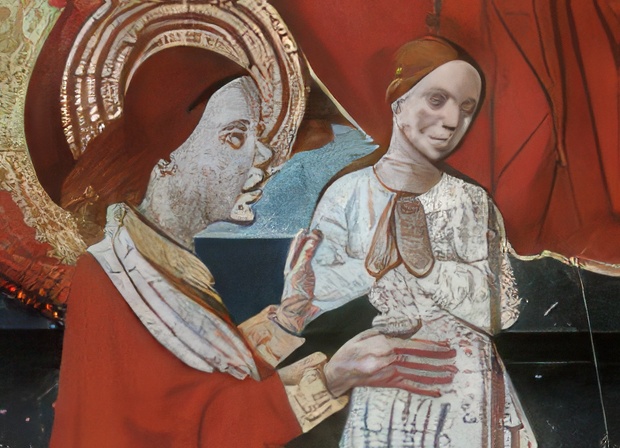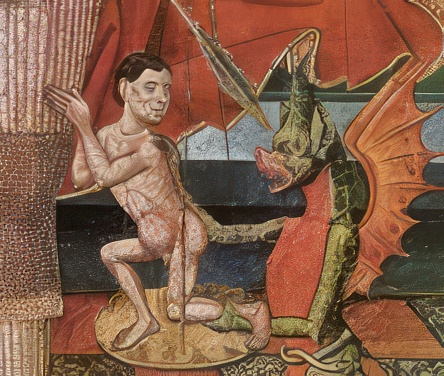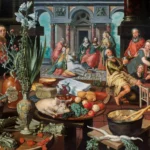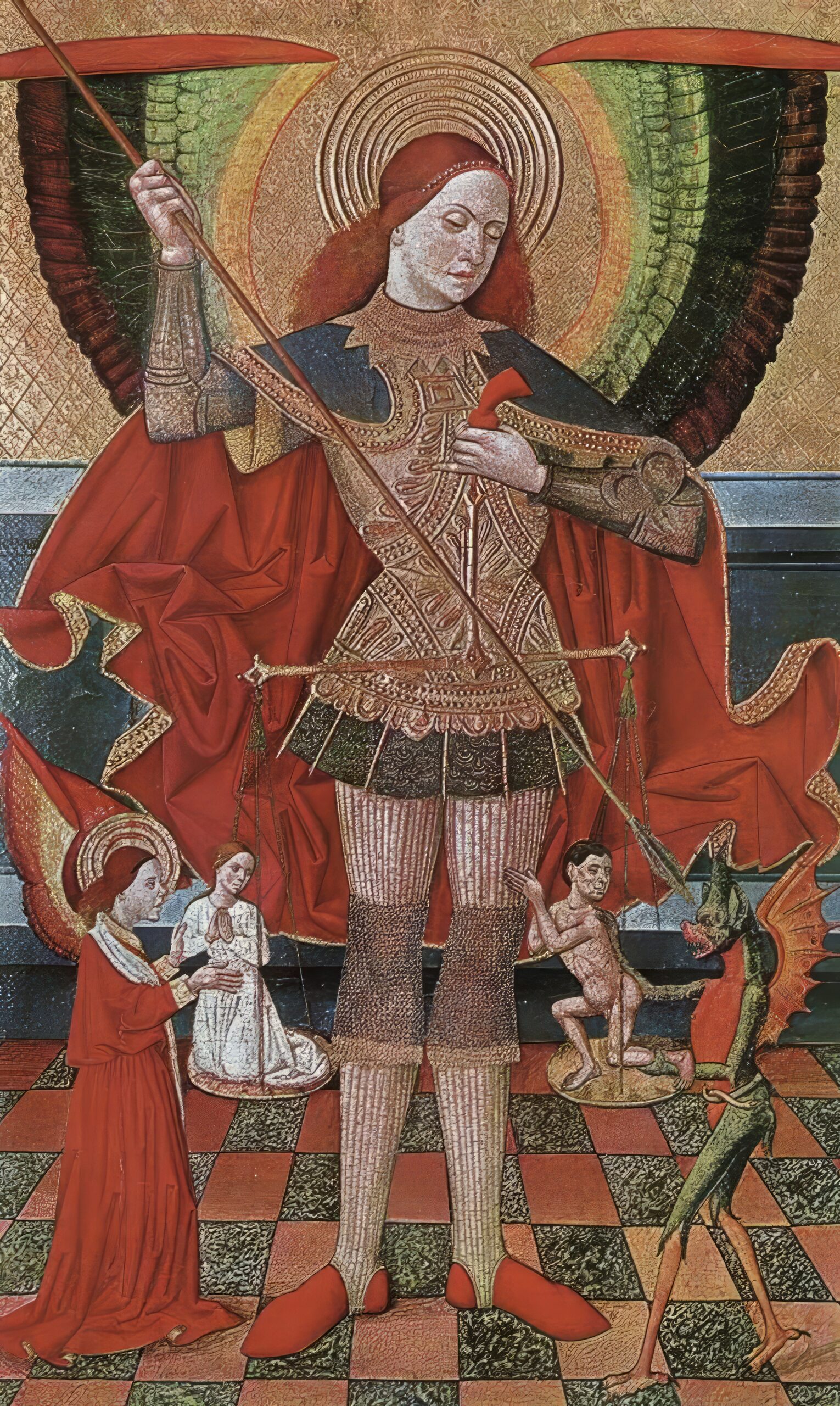
Title: The Archangel Michael
Artist Name: Juan de la Abadia
Genre: Gothic Religious Panel Painting
Date: c. 1490
Dimensions: 127 x 78 cm
Materials: Tempera and gold leaf on wood panel
Location: Museu Nacional d’Art de Catalunya, Barcelona
Divine Light and Sacred Power
As I gaze at Juan de la Abadia’s masterwork, I find myself drawn into a world where divine power takes physical shape. The painting shows such mastery of late medieval Spanish technique that it pulls me in completely. That stunning red – it’s not just any red, but a deep, blood-rich shade that fills nearly half the panel. The way it flows around Saint Michael’s figure reminds me of liquid fire.
The gold background isn’t flat or dull like you might see in lesser works. No – it catches light differently from every angle, creating this sense of movement that makes the whole painting feel alive. I’ve spent hours studying how Abadia worked the surface, and I can tell you – this isn’t just craftsmanship, it’s pure artistic genius.
What really catches my eye is how the armor seems to change as you look at it. From one angle, it’s all hard edges and military strength. But shift your position just slightly, and suddenly you notice all these incredibly delicate patterns worked into the metal. The way Abadia painted it, you’d swear you could reach out and feel the cool metal under your fingers.
The face is something special too. There’s this wonderful tension in how Abadia painted it – strength and gentleness all mixed together. The skin tones are so subtle, built up in layers that create this otherworldly effect. And those eyes – they’re not just painted, they seem to look right through you.
Down at the bottom of the panel, there’s this fascinating checkerboard floor. At first glance, it might seem simple, but look closer. The way Abadia handled the perspective is brilliant – it anchors the whole composition while simultaneously suggesting something beyond our ordinary world. The small figures placed there – each one tells its own story, adding layers of meaning to the whole work.
The craftsmanship in the details is extraordinary. Look at how the saint’s mail armor catches the light – each tiny ring painted with perfect precision. The sword he holds isn’t just a weapon, it’s a symbol of divine justice, and Abadia painted it with such care that you can almost hear it cutting through the air.
The composition itself shows real artistic courage. That bold red cloak sweeping across the panel creates this dynamic energy that brings the whole piece to life. The way it contrasts with the gold background – it’s like watching dawn break across a golden sky.
Sacred Intimacy in Detail
The face of Abadia’s Archangel Michael draws me into a moment of profound artistic contemplation. Here, in this detail, I see the master’s hand working with extraordinary subtlety. The skin tones shift from cool ivory to warm rose, creating a depth that seems to pulse with life beneath the surface.
The way Abadia handled the modeling of the face shows remarkable sensitivity. Those gentle shadows under the cheekbones, the soft curve of the jaw – they’re not just anatomical features, but expressions of divine grace made tangible. The downcast eyes particularly captivate me. Their gentle angle suggests both authority and mercy, while the fine lines around them reveal Abadia’s masterful control of his brush.
What strikes me most is the halo’s interaction with the figure. Those concentric circles of gold don’t just frame the face – they create a rhythm that pulls the eye inward. The reddish-brown hair provides a crucial transition between the ethereal gold and the earthly flesh tones. It’s painted with such care that you can almost count individual strands, yet it maintains a spiritual quality that transcends mere physical representation.
Notice how the light catches differently on various parts of the face. The high forehead reflects it most strongly, creating an almost pearl-like luminosity that suggests divine wisdom. The shadows deepen gradually toward the neck, grounding the ethereal quality of the face in human form. This balance between heavenly and earthly aspects reveals Abadia’s deep understanding of his subject matter.
Sacred Communion in Detail
In this remarkable detail from Abadia’s masterwork, I find myself drawn into an intimate moment of spiritual dialogue. The artist presents two figures with striking psychological depth – the main figure in reverent attention and another in pure white garments, their poses suggesting a sacred exchange that transcends mere physical presence.
The composition here reveals Abadia’s profound understanding of spiritual hierarchy. The leftward figure, bearing the golden nimbus, maintains that characteristic downward gaze we noted earlier, but now we see its full significance in relation to the white-robed figure. The interplay of their positioning creates a visual dialogue that speaks volumes about medieval concepts of divine mediation.
The technical execution particularly moves me. Look at how the white garment catches light – Abadia achieved this effect through careful layering of paint, creating a luminosity that seems to emanate from within the figure itself. The folds fall with a natural grace that belies their careful arrangement in the composition.
What fascinates me most is the subtle color harmony at play. The warm golden tones of the nimbus echo through the scene, picking up hints in the flesh tones and creating a unified visual field that draws these figures into intimate communion. The artist’s command of spatial relationships shows remarkable sophistication – these figures exist in a space that’s both physical and metaphysical.
The architectural elements visible in the background provide crucial context while simultaneously lifting the scene beyond mere earthly reality. That checkered floor pattern we saw in the full work takes on new meaning here, grounding this sacred interaction in a space that bridges heavenly and earthly realms.
The Depths of Darkness
In this charged detail from Abadia’s masterwork, I encounter a remarkable visualization of spiritual warfare. The artist has created a deeply unsettling yet fascinating corner of the composition, where the battle between good and evil takes physical form through masterful medieval craftsmanship.
The demon figure strikes me with its raw physicality. Abadia painted it in earthy flesh tones that contrast sharply with the spiritual gold and red of the main panel. The creature’s twisted posture speaks of inner corruption made visible. Its nakedness isn’t just an artistic choice – it represents a profound spiritual nakedness, stripped of divine grace.
The dragon appears in deep green tones, a color choice that merits careful attention. This isn’t the vibrant green of living things, but a darker, more sinister shade that seems to absorb light rather than reflect it. The way its wings catch the red glow from above creates an almost metallic effect, suggesting both its otherworldly nature and its fallen state.
What particularly draws my eye is the dynamic tension in this small scene. The figures are caught in a moment of eternal struggle, yet Abadia manages to suggest movement within the confined space. The checkered floor pattern we saw in the larger work takes on new meaning here – it becomes almost like a chess board where this cosmic game plays out.
The technical execution shows remarkable attention to anatomical detail, even in these grotesque forms. Each muscle and sinew is carefully rendered, making the supernatural feel disturbingly natural. The shadows pooling around the figures create depth that pulls the eye into this dark corner of the spiritual realm.
The Sacred Art of Juan de la Abadia: A Final Reflection
Standing before this masterwork from medieval Spain, I find myself deeply moved by the ways Abadia brought together technical brilliance and spiritual truth. His Archangel Michael embodies that rare fusion of artistic mastery and theological depth that marks the finest religious art of any age.
The painting speaks in multiple visual languages at once. Through his masterful use of color – particularly that blood-rich red against celestial gold – Abadia creates a space where earthly and heavenly realms meet and mingle. The artist’s profound understanding of his craft shows in every detail: the play of light across metal armor, the subtle modeling of holy flesh, the dramatic sweep of fabric that seems to hold divine energy in its folds.
The work’s power lies not just in its technical excellence but in its deeper spiritual resonance. Through Abadia’s brush, we see how medieval Spanish art could transform raw materials – wood, pigment, gold leaf – into a window onto divine reality. The painting doesn’t just show us an archangel; it makes the very concept of divine protection tangible and present.
This piece stands as a testament to a time when art served as both aesthetic achievement and spiritual instruction. In Abadia’s hands, these purposes merge seamlessly. The painting continues to speak across centuries, showing us how great art can make the invisible visible, the divine tangible, the spiritual real.
The Sacred Hand: Juan de la Abadia’s Artistic Legacy
Juan de la Abadia emerges from the rich artistic soil of 15th-century Aragon as a master whose brush transformed sacred narratives into visual poetry. Active in Huesca between 1470 and 1498, this Spanish painter manifested the complex theological ideas of his time through a distinctive visual language that bridged medieval tradition with emerging Renaissance sensibilities.
His artistic formation occurred within the vibrant cultural nexus of northern Spain, where Gothic traditions merged with new aesthetic currents flowing from across the Pyrenees. Working primarily in Huesca and its surrounding regions, Abadia developed a style characterized by elegant linearity, rich chromatic harmonies, and profound spiritual presence.
The corpus of his work centers on religious subjects, with notable altarpieces commissioned for churches throughout Aragon. His workshop, situated in the shadow of Huesca Cathedral, became a crucible where pigment and devotion merged to create works of extraordinary spiritual potency. The Archangel Michael panel exemplifies his mature style, where technical virtuosity serves as a vehicle for divine contemplation.
Documentary evidence places him among Huesca’s most sought-after painters of his time. His influence extends through several documented apprentices who carried forward his distinctive fusion of technical precision and spiritual depth. Though his complete oeuvre remains partially obscured by time, surviving works testify to an artist who understood painting as both craft and sacred vocation.
© Byzantica.com. Permission is granted to use this material for non-commercial purposes only, provided that you include proper attribution to ‘Byzantica.com UHD Christian Gallery (www.byzantica.com)’ and an active hyperlink to this post.
